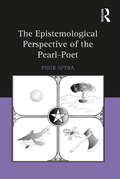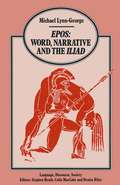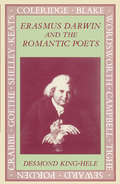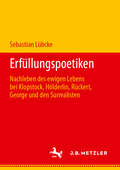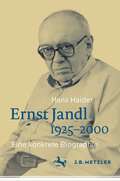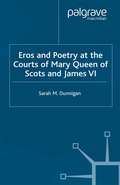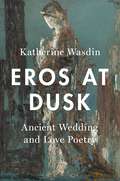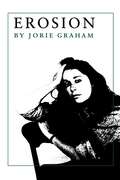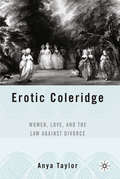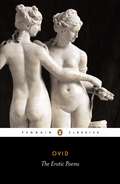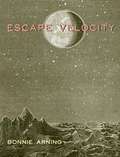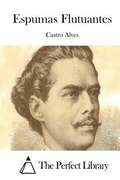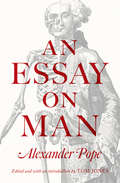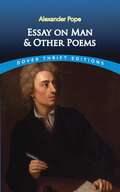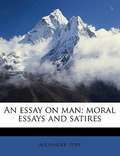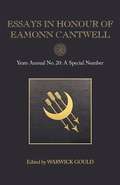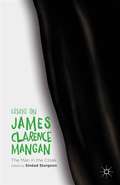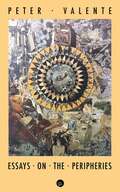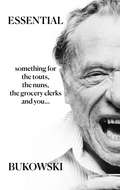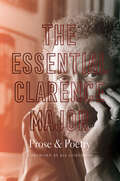- Table View
- List View
The Epistemological Perspective of the Pearl-Poet
by Piotr SpyraOriginal and engaging, this study presents the four anonymous poems found in the Cotton Nero MS - Pearl, Cleanness, Patience, and Sir Gawain and the Green Knight - as a composite text with a continuous narrative. While it is widely accepted that the poems attributed to the Pearl-Poet ought to be read together, this book demonstrates that instead of being analyzed as four distinct, though interconnected, textual entities, they ought to be studied as a single literary unit that produces meaning through its own intricate internal structure. Piotr Spyra defines the epistemological thought of Saint Augustine as an interpretive key which, when applied to the composite text of the manuscript, reveals a fabric of thematic continuity. This book ultimately provides the reader with a clear sense of the poet's perspective on the nature of human knowledge as well as its moral implications and with a deeper understanding of how the poems bring the theological and philosophical problems of the Middle Ages to bear on the individual human experience.
Erasmus Darwin and the Romantic Poets
by D. King-HeleErasmus Darwin (1731-1802) had the highest reputation among living English poets during much of the 1790s, through the great success of his long poem in rhyming couplets, The Botanic Garden, published complete in 1792. In this new book Desmond King-Hele shows in convincing detail how Darwin greatly influenced five major English Romantic poets, Blake, Wordsworth, Coleridge, Shelley and Keats, and many other poets of the time, such as Crabbe and Campbell (but not Byron).
Erfüllungspoetiken: Nachleben des ewigen Lebens bei Klopstock, Hölderlin, Rückert, George und den Surrealisten
by Sebastian LübckeSebastian Lübcke untersucht philosophische und literarische Auseinandersetzungen mit der Erfüllung und dem ontologisch Absoluten vom 18. bis ins 20. Jahrhundert. Dabei zeigt sich, dass Texte, die sich in der Neuzeit mit dem ‚Göttlichen‘ oder dem ‚ewigen Leben‘ befassen, trotz ihrer mitunter antichristlichen Programmatiken immer wieder von ‚klassischen‘ christlichen Denk- und Darstellungsfiguren eingeholt werden. An einer ‚erfüllungspoetischen‘ Traditionslinie von Klopstock, Hölderlin, Rückert, George und den Surrealisten legt der Autor dar, wie in Lyrik und Poetik der Anspruch erhoben wird, die erfüllte Zeit des ‚ewigen Lebens‘ – nach der je eigenen Vorstellung der Autoren freilich – in der ‚ästhetischen Eigenzeit‘ der Gedichte realsymbolisch gegenwärtig zu machen.
Ernest Fenollosa -- The Chinese Written Character As A Medium For Poetry: Ars poetica or The Roots of Poetic Creation?
by Flemming OlsenThe first decade of the 20th century witnessed a calling into question of some of the central positions held by the late 19th century Positivists. There was a shift of paradigm in science as well as art, as elicited by Einstein, William James, Freud, Picasso, Bergson and Pound. The insufficiency of the Positivist world picture became increasingly evident. Importantly, the concept of what was conventionally called reality, and legitimate ways of describing it, were being transformed. Fenollosa's long essay, "The Chinese Written Character as a Medium for Poetry", was a ground-breaking, if idiosyncratic, poetic criticism, as well as a significant illustration of prevalent intellectual concerns. The role of the individual word in creating images was central to Fenollosa's interest, as it was to the majority of contemporary poets and critics, but he found an intriguing prototype in the Chinese pictogram, which conveys an item of information via a concrete, more or less stylised, illustration. Flemming Olsen follows Fenollosa's theorising, showing the extent to which it is indebted to, and shaped by, post-Positivist tenets. The current cult of dynamism is reflected in Fenollosa's idea of metaphor, which he sees as a linguistic manifestation of the Bergsonian elan, which is the driving force behind everything. This explains his predilection for sentences with a transitive verb, which signals action, and his aversion to the stasis of grammar, logic and the copula. Equally, truth is not seen by Fenollosa as the accordance between observed facts and some pre-established metaphysical entity, as held by positivist science, but as a labile concept; it is "something that happens", determined by a context -- an idea pursued, for example, by the "absurd" dramatists. The picture of "reality" given by the poetical image could be just as truthful as the picture given by science. Reality thus moves from being "our" reality, to become "my" reality. Fenollosa was not a literary critic; he was an orientalist by profession. Yet his linguistic ideas, although presented in a rudimentary form and without any elaborate terminology, foreshadow linguists' concentration on, and analysis of, the medium just as much as the message. Pound's contention that Fenollosa's essay is a modern ars poetica is shown to be exaggerated; its interest rather lies in Fenollosa's endeavour to go to the roots of poetic creation.
Ernst Jandl 1925–2000: Eine konkrete Biographie
by Hans HaiderErnst Jandl (1925–2000) gehört zu den wichtigsten Lyrikern des 20. Jahrhunderts. Mit Lettern- und Lautgedichten machte er sich in den 1950er Jahren in seiner Heimat Wien zum Außenseiter, fand jedoch rasch Anerkennung in den Zentren der Konkreten Poesie in Stuttgart, Prag, London. Wie ein Popstar entführte er bei lautstarken Auftritten die Jugend der Revolte-Generation mit Sprachwitz und -spiel in die Schmerzbezirke von Krieg, absurdem Alltag, Liebesdefizit. Er setzte dem hohen Ton eine „heruntergekommene“ Sprache und unterkühlten Dialekt entgegen. Mit der Lebenspartnerin Friederike Mayröcker schuf er Pionierwerke des ‚Neuen Hörspiels‘. Hans Haider legt nach Archivrecherchen in halb Europa und jahrzehntelanger Tätigkeit in der Wiener Kulturszene als Kritiker und Herausgeber die erste umfassende Jandl-Biographie vor.
Eros and Poetry at the Courts of Mary Queen of Scots and James VI (Early Modern Literature in History)
by S. DunniganEros and Poetry examines the erotics of literary desire at the Stewart court in Scotland during the reigns of Mary, Queen of Scots and James VI. Encompassing the period from the early 1560s to the late 1590s, this is the first study to link together Scottish Marian and Jacobean court literatures, presenting a relatively unknown body of writing, newly theorized and contextualized. It argues that in this period erotic poetry can only be considered in relation to the figure of the monarch, and that the formation of elite lyric culture takes place under the shaping influence of desire for, and against, the sovereign, and her or his 'passional' and symbolic powers.
Eros at Dusk: Ancient Wedding and Love Poetry
by Katherine WasdinThis book analyzes the relationship between wedding poetry and love poetry in the classical world. By treating both Greek and Latin texts, it offers an innovative and wide-ranging discussion of the poetic representation of social occasions. The discourses associated with weddings and love affairs both foreground ideas of persuasion and praise even though they differ dramatically in their participants and their outcomes. Furthermore, these texts make it clear that the brief, idealized, and eroticized moment of the wedding stands in contrast to the long-lasting and harmonious agreement of the marriage. At times, these genres share traditional forms of erotic persuasion, but at other points, one genre purposefully alludes to the other to make a bride seem like a paramour or a paramour like a bride. Explicit divergences remind the audience of the different trajectories of the wedding, which will hopefully transition into a stable marriage, and the love affair, which is unlikely to endure with mutual affection. Important themes include the threshold; the evening star; plant and animal metaphors; heroic comparisons; reciprocity and the blessings of the gods; and sexual violence and persuasion. The consistency and durability of this intergeneric relationship demonstrates deep-seated conceptions of legitimate and illegitimate sexual relationships. By examining these two types of poetry in tandem, Eros at Dusk adds fresh insight into the social concerns and generic composition of these occasional poems.
Eros at Dusk: Ancient Wedding and Love Poetry
by Katherine WasdinThis book analyzes the relationship between wedding poetry and love poetry in the classical world. By treating both Greek and Latin texts, it offers an innovative and wide-ranging discussion of the poetic representation of social occasions. The discourses associated with weddings and love affairs both foreground ideas of persuasion and praise even though they differ dramatically in their participants and their outcomes. Furthermore, these texts make it clear that the brief, idealized, and eroticized moment of the wedding stands in contrast to the long-lasting and harmonious agreement of the marriage. At times, these genres share traditional forms of erotic persuasion, but at other points, one genre purposefully alludes to the other to make a bride seem like a paramour or a paramour like a bride. Explicit divergences remind the audience of the different trajectories of the wedding, which will hopefully transition into a stable marriage, and the love affair, which is unlikely to endure with mutual affection. Important themes include the threshold; the evening star; plant and animal metaphors; heroic comparisons; reciprocity and the blessings of the gods; and sexual violence and persuasion. The consistency and durability of this intergeneric relationship demonstrates deep-seated conceptions of legitimate and illegitimate sexual relationships. By examining these two types of poetry in tandem, Eros at Dusk adds fresh insight into the social concerns and generic composition of these occasional poems.
Erosion
by Jorie GrahamFrom Erosion:SAN SEPOLCRO Jorie Graham ? . . . . How cleanthe mind is,holy grave. It is this girlby Pierodella Francesca, unbuttoningher blue dress,her mantle of weather,to go intolabor. Come, we can go in.It is beforethe birth of god. No-onehas risen yetto the museums, to the assemblyline bodiesand wings to the open airmarket. This iswhat the living do: go in.It's a long way.And the dress keeps openingfrom eternityto privacy, quickening.Inside, at the heart,is tragedy, the present momentforever stillborn,but going in, each breathis a buttoncoming undone, something terriblynimble-fingeredfinding all of the stops. Jorie Graham grew up in Italy and now lives in northern California.She has received grants from the Ingram-Merrill Foundation, the Bunting Institute, and the John Simon Guggenheim Memorial Foundation.Her first book, Hybrids of Plants and of Ghosts (Princeton, 1980), won the Great Lakes Colleges Association Award as the best first book of poems published in 1980.
Erosion
by Jorie GrahamFrom Erosion:SAN SEPOLCRO Jorie Graham ? . . . . How cleanthe mind is,holy grave. It is this girlby Pierodella Francesca, unbuttoningher blue dress,her mantle of weather,to go intolabor. Come, we can go in.It is beforethe birth of god. No-onehas risen yetto the museums, to the assemblyline bodiesand wings to the open airmarket. This iswhat the living do: go in.It's a long way.And the dress keeps openingfrom eternityto privacy, quickening.Inside, at the heart,is tragedy, the present momentforever stillborn,but going in, each breathis a buttoncoming undone, something terriblynimble-fingeredfinding all of the stops. Jorie Graham grew up in Italy and now lives in northern California.She has received grants from the Ingram-Merrill Foundation, the Bunting Institute, and the John Simon Guggenheim Memorial Foundation.Her first book, Hybrids of Plants and of Ghosts (Princeton, 1980), won the Great Lakes Colleges Association Award as the best first book of poems published in 1980.
Erotic Coleridge: Women, Love and the Law Against Divorce
by A. TaylorErotic Coleridge charts Coleridge's prolific creation of love poems from early flirtatious verse to poems about marital incompatibility, the blank faces of young women fearing for their reputations, the obliterating seductions of young women, the exaltation of falling in love, the spoken and sung voices of women, the pain of jealousy, and late meditations on how to live with the waning of love. In his prose he responds to Parliamentary debates about punishing adulteresses and gives advice about how marriage can warp the soul. In his sensual exuberance and his ethics of reverencing the individuality of other persons, Coleridge attends closely to the lives of women.
The Erotic Poems
by Peter Green OvidThis collection of Ovid's poems deals with the whole spectrum of sexual desire, ranging from deeply emotional declarations of eternal devotion to flippant arguments for promiscuity. In the Amores, Ovid addresses himself in a series of elegies to Corinna, his beautiful, elusive mistress. The intimate and vulnerable nature of the poet revealed in these early poems vanishes in the notorious Art of Love, in which he provides a knowing and witty guide to sexual conquest - a work whose alleged obscenity led to Ovid's banishment from Rome in AD 8. This volume also includes the Cures for Love, with instructions on how to terminate a love affair, and On Facial Treatment for Ladies, an incomplete poem on the art of cosmetics.
Escape Velocity (Mountain West Poetry Series)
by Bonnie ArningFrom the moment of a marriage’s heated inception to its period of luminous crowding and onward into distance and darkness, Bonnie Arning’s Escape Velocity asks if it’s possible to exist outside the only universe we’ve ever known. In modes both lyric and narrative, we are given a peephole into the height and decline of a marriage that begins beneath the moving lights of Las Vegas, Nevada, and traverses the devastating terrain of gambling, miscarriage, infidelity, and violence. Arning gives voice to divergent aspects of love and violence through her use of math problems, erasures, dictionary entries, structured stanzas, and sprawling free verse. This multiplicity of forms comes together to explore everything from pop culture references of domestic violence to cultural notions of victims and victimhood. However dark, collectively these poems tell a love story—an acceptance of our capability to love those who hurt us, but also the love-of-self required to slowly and steadily reach "the velocity to be everleaving." In the tradition of Eavan Boland and Louise Glück, Arning wrestles down and examines the terrible without flinching. We journey with her, engrossed by each difficult truth: a precipice near which we are both terrified to stand and transfixed by its unnerving insistence on beauty.
Espumas Flutuantes
by Castro Alves"Espumas Flutuantes" from Castro Alves. Poeta brasileiro (1847-1871).
An Essay on Man
by Alexander Pope Tom JonesVoltaire called it "the most sublime didactic poem ever written in any language." Rousseau rhapsodized about its intellectual consolations. Kant recited long passages of it from memory during his lectures. And Adam Smith and David Hume drew inspiration from it in their writings. This was Alexander Pope's Essay on Man (1733–34), a masterpiece of philosophical poetry, one of the most important and controversial works of the Enlightenment, and one of the most widely read, imitated, and discussed poems of eighteenth-century Europe and America. This volume, which presents the first major new edition of the poem in more than fifty years, introduces this essential work to a new generation of readers, recapturing the excitement and illuminating the debates it provoked from the moment of its publication.Echoing Milton's purpose in Paradise Lost, Pope says his aim in An Essay on Man is to "vindicate the ways of God to man"—to explain the existence of evil and explore man's place in the universe. In a comprehensive introduction, Tom Jones describes the poem as an investigation of the fundamental question of how people should behave in a world they experience as chaotic, but which they suspect to be orderly from some higher point of view. The introduction provides a thorough discussion of the poem's attitudes, themes, composition, context, and reception, and reassesses the work's place in history. Extensive annotations to the text explain references and allusions.The result is the most accessible, informative, and reader-friendly edition of the poem in decades and an invaluable book for students and scholars of eighteenth-century literature and thought.
Essay on Man and Other Poems: And Other Poems (Dover Thrift Editions)
by Alexander PopeConsidered the preeminent verse satirist in English, Alexander Pope (1688-1744) brought wide learning, devastating wit and masterly technique to his poems. Models of clarity and control, they exemplified the classical poetics of the Augustan age.This volume contains a rich selection of Pope's work, including such well-known poems as the title selection — a philosophical meditation on the nature of the universe and man's place in it — and "The Rape of the Lock," a mock-epic of rare charm and skill. Also included are "Ode on Solitude," "The Dying Christian to His Soul," "Elegy to the Memory of an Unfortunate Lady," "An Essay on Criticism," "Epigram Engraved on the Collar of a Dog," "Epistle [IV] to Richard Boyle, Earl of Burlington: Of the Use of Riches," "Epistle to Dr. Arbuthnot; or, Prologue to the Satires" and more.Taken together, these poems offer an excellent sampling of Pope's imaginative genius and the felicitous blending of word, idea and image that earned him a place among the leading lights of 18th-century literature.
An Essay on Man; Moral Essays and Satires
by Alexander PopeAn Essay on Man is a poem published by Alexander Pope in 1733-1734. It is an effort to rationalize or rather "vindicate the ways of God to man" (l.16), a variation of John Milton's claim in the opening lines of Paradise Lost, that he will "justify the ways of God to men" (1.26). <P> <P> It is concerned with the natural order God has decreed for man. Because man cannot know God's purposes, he cannot complain about his position in the Great Chain of Being (ll.33-34) and must accept that "Whatever IS, is RIGHT" (l.292), a theme that was satirized by Voltaire in Candide (1759). More than any other work, it popularized optimistic philosophy throughout England and the rest of Europe.
An Essay on Man (PDF)
by Alexander Pope Tom JonesVoltaire called it "the most sublime didactic poem ever written in any language." Rousseau rhapsodized about its intellectual consolations. Kant recited long passages of it from memory during his lectures. And Adam Smith and David Hume drew inspiration from it in their writings. This was Alexander Pope's Essay on Man (1733–34), a masterpiece of philosophical poetry, one of the most important and controversial works of the Enlightenment, and one of the most widely read, imitated, and discussed poems of eighteenth-century Europe and America. This volume, which presents the first major new edition of the poem in more than fifty years, introduces this essential work to a new generation of readers, recapturing the excitement and illuminating the debates it provoked from the moment of its publication.Echoing Milton's purpose in Paradise Lost, Pope says his aim in An Essay on Man is to "vindicate the ways of God to man"—to explain the existence of evil and explore man's place in the universe. In a comprehensive introduction, Tom Jones describes the poem as an investigation of the fundamental question of how people should behave in a world they experience as chaotic, but which they suspect to be orderly from some higher point of view. The introduction provides a thorough discussion of the poem's attitudes, themes, composition, context, and reception, and reassesses the work's place in history. Extensive annotations to the text explain references and allusions.The result is the most accessible, informative, and reader-friendly edition of the poem in decades and an invaluable book for students and scholars of eighteenth-century literature and thought.
Essays in Honour of Eamonn Cantwell: Yeats Annual No. 20 (Yeats Annual #20)
by Warwick GouldThis number of Yeats Annual collects the essays resulting from the University College Cork/ESB International Annual W. B. Yeats Lectures Series (2003-2008) by Roy Foster, Warwick Gould, John Kelly, Paul Muldoon, Bernard O’Donoghue and Helen Vendler. Those that were available in pamphlet form are now collectors’ items, but here is the complete series. These revised essays cover such themes as Yeats and the Refrain, Yeats as a Love Poet, Yeats, Ireland and Europe, the puzzles he created and solved with his art of poetic sequences, and his long and crucial interaction with the emerging T. S. Eliot. The series was inaugurated by a study of Yeats and his Books, which marked the gift to the Boole Library, Cork, of Dr Eamonn Cantwell’s collection of rare editions of books by Yeats (here catalogued by Crónán Ó Doibhlin). Many of the volume’s fifty-six plates offer images of artists’ designs and resulting first editions. This bibliographical theme is continued with Colin Smythe’s census of surviving copies of Yeats’s earliest separate publication, Mosada (1886) and a resultant piece by Warwick Gould on that dramatic poem’s source in the legend of the Phantom Ship. John Kelly reveals Yeats’s ghost-writing for Sarah Allgood; Geert Lernout discovers the source for Yeats’s ‘Tulka’, Günther Schmigalle unearths his surprising connexions with American communist colonists in Virginia, while Deirdre Toomey edits some new letters to the French anarchist, Auguste Hamon—all providing new annotation for standard editions. The volume is rounded with review essays by Colin McDowell (on A Vision, and Yeats, Hone and Berkeley), shorter reviews of current studies by Michael Edwards, Jad Adams and Deirdre Toomey, and obituaries of Jon Stallworthy (Nicolas Barker) and Katharine Worth (Richard Cave).
Essays in Honour of Eamonn Cantwell: Yeats Annual No. 20 (PDF)
by Warwick GouldThis number of Yeats Annual collects the essays resulting from the University College Cork/ESB International Annual W. B. Yeats Lectures Series (2003-2008) by Roy Foster, Warwick Gould, John Kelly, Paul Muldoon, Bernard O’Donoghue and Helen Vendler. Those that were available in pamphlet form are now collectors’ items, but here is the complete series. These revised essays cover such themes as Yeats and the Refrain, Yeats as a Love Poet, Yeats, Ireland and Europe, the puzzles he created and solved with his art of poetic sequences, and his long and crucial interaction with the emerging T. S. Eliot. The series was inaugurated by a study of Yeats and his Books, which marked the gift to the Boole Library, Cork, of Dr Eamonn Cantwell’s collection of rare editions of books by Yeats (here catalogued by Crónán Ó Doibhlin). Many of the volume’s fifty-six plates offer images of artists’ designs and resulting first editions. This bibliographical theme is continued with Colin Smythe’s census of surviving copies of Yeats’s earliest separate publication, Mosada (1886) and a resultant piece by Warwick Gould on that dramatic poem’s source in the legend of the Phantom Ship. John Kelly reveals Yeats’s ghost-writing for Sarah Allgood; Geert Lernout discovers the source for Yeats’s ‘Tulka’, Günther Schmigalle unearths his surprising connexions with American communist colonists in Virginia, while Deirdre Toomey edits some new letters to the French anarchist, Auguste Hamon—all providing new annotation for standard editions. The volume is rounded with review essays by Colin McDowell (on A Vision, and Yeats, Hone and Berkeley), shorter reviews of current studies by Michael Edwards, Jad Adams and Deirdre Toomey, and obituaries of Jon Stallworthy (Nicolas Barker) and Katharine Worth (Richard Cave).
Essays on James Clarence Mangan: The Man in the Cloak
by Sinéad SturgeonThis is the first collection of essays to focus on the extraordinary literary achievement of James Clarence Mangan (1803-1849), increasingly recognized as one of the most important Irish writers of the nineteenth century. It features contributions by acclaimed contemporary writers including Paul Muldoon and Ciaran Carson.
Essays on the Peripheries
by Peter ValenteEssays on the Peripheries contains essays written by translator and scholar Peter Valente over a twenty-year period, stretching from the 1990s to 2019. They are a record of literary exploration and discovery, concerned with the recovery of lost works, with those writers whose works were out of print or hard to find, and whose names were somehow not fashionable in the current discourse, but who are important nevertheless. Edouard Roditi, Barbara Barg, and Tom Savage, for example, should be better known, but their books are largely ignored. This collection of essays highlights those works on the periphery, such as Turkish poets Seyhan Erözçelik and Küçük İskender, while it also includes several essays on better-known queer authors like Pierre Guyotat and Pier Paolo Pasolini, focusing on often overlooked qualities in their work that bear looking at closely. These essays on works of literature are complemented by a number of texts on jazz, again highlighting important and interesting figures in the world of jazz and free improvisation that may have fallen through the cracks, such as the pianist Richard Twardzick and the Ganelin trio, which recorded their great experimental work Ancora da Capo in 1980, behind the Iron Curtain. Attention is also to given to more popular figures such as Stan Getz. The volume is completed with a series of essays reappraising Roman poets in the twenty-first century, offering fresh new translations and readings of authors such as Catullus and Callimachus. A collection of essays, like an anthology, is by its nature incomplete. Essays on the Peripheries is a kind of sketch, rather than a finished portrait, of the author's changing impressions on various subjects over the years.
Essential Bukowski: Poetry
by Charles Bukowski‘The best poet in America’ Jean Genet ‘He brought everybody down to earth, even the angels’ Leonard Cohen The definitive collection from a writer whose transgressive legacy and raw, funny, acutely observant writing has left an enduring mark
The Essential Clarence Major: Prose and Poetry
by Clarence MajorClarence Major is one of America's literary masters. He has published numerous books, from novels to poetry and short story collections. Among his many accolades, he was a finalist for the National Book Award and a Fulbright scholar and received the PEN Oakland/Reginald Lockett Lifetime Achievement Award. His work has been featured in many literary journals, newspapers, and magazines, including the New Yorker, the New York Times, and Ploughshares.Whether you've known Major's work for decades or are new to his singular style, The Essential Clarence Major offers a thrilling overview of an exceptional career, from his early groundbreaking fiction to his most recent poems. Included here are excerpts from Major's best novels, a selection of his finest short stories and poetry, more than a dozen thought-provoking essays, a taste of his autobiography. Award-winning playwright, novelist, and screenwriter Kia Corthron introduces the collection, artfully illuminating Major's importance as one of the foremost and original voices in contemporary American literature.
